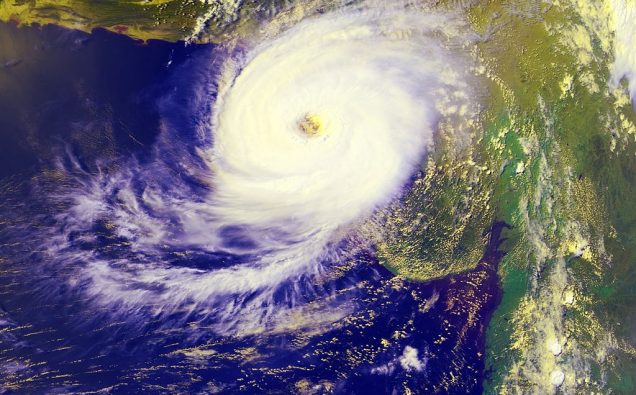
A NASA image of Cyclone 2 making landfall near Karachi Pakistan
More than 62 million South Asian people will be forced to migrate from their homes due to climate disasters by 2050, according to new research from ActionAid International and Climate Action Network South Asia.
Released at a time of the coronavirus pandemic and growing numbers of natural disasters that have already upended lives and traditional ways to work for many around the globe, the report is an eye-opening warning.
Already, implications of political failure to act in time and limit global warming to below 2°C have seen 18 million climate migrants from their homes in the year 2020.
In South Asia alone, climate migration will treble in South Asia alone, compounding problems for a region that has been badly affected by climate disasters including floods, droughts, typhoons, and cyclones.
In uncertain times migrants remain hope for the impoverished with $689 billion remittanceshttps://t.co/aPHw20OBQu#migrants #poverty pic.twitter.com/nXsCP2fCD6
— Views&News (@ViewsNewsMag) November 29, 2019
The research, undertaken by Bryan Jones, one of the authors of the inaugural Groundswell Report on internal climate migration in 2018, was published on International Migrants Day.
The effects on South Asia will be wide-ranging, not limited to just economic urgencies and social ramifications.
The study broadens the analysis to incorporate new drivers of climate migration, which include loss of biodiversity and up to date scenarios of sea level rises and global warming.
Titled, ‘Costs of climate inaction: displacement and distress migration’ assesses climate-fuelled displacement and migration across five South Asian countries, Bangladesh, India, Nepal, Pakistan, and Sri Lanka, and calculates a devastating likelihood of more than 60 million people being homeless and displaced by 2050 in South Asia alone.
This is almost as many people as are forced from their homes globally due to war and conflict, raising the alarm that climate can no longer be overlooked as a major factor driving displacement.
Winter's red hot climate change warnings https://t.co/8YqLr8jFMs#Climatechange #globalwarming #climate pic.twitter.com/1q1ekLhvSf
— Views&News (@ViewsNewsMag) January 24, 2020
Climate migration could easily surpass conflict as a driving force of displacement if political leaders continue to renege on their commitments to reducing greenhouse gas emissions in line with the Paris Agreement. Communities can be resilient to climate change, slow-onset climate disasters, such as sea-level rise, drought, failed harvests, and loss of biodiversity, but this takes money and political will.
The new report by ActionAid calls for strong leadership and ambition from developed countries to cut emissions and support for developing countries to adapt to climate change and recover from climate disasters.
The study recommends a holistic approach that places the onus on rich countries to provide support and urges developing countries to scale up efforts to protect people from climate impacts.
South Asia is particularly prone to climate disasters and has some of the highest levels of climate-fuelled displacement.
The research reveals that in all five countries, women are left dealing with the negative fallout from climate migration. They are left behind to take care of household chores, agricultural activities, look after children and the elderly and manage livestock. Women who migrate to urban settlements are often then forced to take up work in precarious settings where workers’ rights violations are rife.
The change of guard at the White House has raised hopes for action against climate change with President Joe Biden’s Administration joining the Paris Climate Accord. That may be a great step at the global level. But the regional countries like South Asian states need to show leadership and may need some support from the world’s leading institutions and countries. In this respect, the appoint of John Kerry, as Special Envoy on Climate Change looks like a step in the right direction.


















